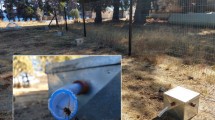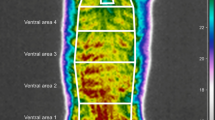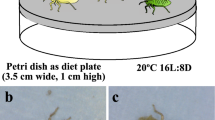Abstract
Eusociality, which occurs among mammals only in two species of African mole-rat, is characterized by division of labour between morphologically distinct ‘castes’1. In Damaraland mole-rats (Cryptomys damarensis), colony labour is divided between ‘infrequent worker’ and ‘frequent worker’ castes2. Frequent workers are active year-round and together perform more than 95% of the total work of the colony, whereas infrequent workers typically perform less than 5% of the total work3. Anecdotal evidence suggests that infrequent workers may act as dispersers, with dispersal being limited to comparatively rare periods when the soil is softened by moisture4,5. Here we show that infrequent workers and queens increase their daily energy expenditure after rainfall whereas frequent workers do not. Infrequent workers are also fatter than frequent workers. We suggest that infrequent workers constitute a physiologically distinct dispersing caste, the members of which, instead of contributing to the work of the colony and helping the queen to reproduce, build up their own body reserves in preparation for dispersal and reproduction when environmental conditions are suitable.
This is a preview of subscription content, access via your institution
Access options
Subscribe to this journal
Receive 51 print issues and online access
$199.00 per year
only $3.90 per issue
Buy this article
- Purchase on Springer Link
- Instant access to full article PDF
Prices may be subject to local taxes which are calculated during checkout

Similar content being viewed by others
References
Jarvis, J. U. M., O'Riain, M. J., Bennett, N. C. & Sherman, P. W. Mammalian eusociality: a family affair. Trends Ecol. Evol. 9, 46–51 (1994)
Bennett, N. C. & Jarvis, J. U. M. The social structure and reproductive biology of colonies of the mole-rat Cryptomys damarensis (Rodentia: Bathyergidae). J. Mamm. 69, 293–302 (1988)
Bennett, N. C. & Faulkes, C. G. African Mole-rats Ecology and Eusociality 273 (Cambridge Univ. Press, Cambridge, 2000)
Hazell, R. W. A., Bennett, N. C., Jarvis, J. U. M. & Griffin, M. Adult dispersal in the cooperatively breeding Damaraland mole-rat, Cryptomys damarensis: a case study from the Waterberg region of Namibia. J. Zool. 252, 19–26 (2000)
Jarvis, J. U. M. & Bennett, N. C. Eusociality has evolved independently in two genera of bathyergid mole-rats—but occurs in no other subterranean mammal. Behav. Ecol. Sociobiol. 33, 353–360 (1993)
Stacey, P. B. & Koenig, W. D. Cooperative Breeding in Birds (Univ. Cambridge press, Cambridge, 1990)
Solomon, N. G. & French, J. F. Cooperative Breeding in Mammals (Cambridge Univ. Press, Cambridge, 1997)
Emlen, S. T. in Behavioural Ecology an Evolutionary Approach 4th edn (eds Krebs, J. R. & Davies, N. B.) 228–253 (Blackwell, Oxford, 1997)
Emlen, S. T. in Behavioural Ecology an Evolutionary Approach 2nd edn (eds Krebs, J. R. & Davies, N. B.) 301–337 (Blackwell, Oxford, 1991)
Keller, L. & Reeve, H. K. Partitioning of reproduction in animal societies. Trends Ecol. Evol. 9, 98–102 (1994)
Waterman, J. M. Mating tactics of male Cape ground squirrels, Xerus inauris: consequences of year-round breeding. Anim. Behav. 56, 459–466 (1998)
O'Riain, M. J., Jarvis, J. U. M. & Faulkes, C. G. A dispersive morph in the naked mole-rat. Nature 380, 619–621 (1996)
Speakman, J. R. Doubly Labelled Water, Theory and Practice (Chapman and Hall, London, 1997)
Scantlebury, M., Oosthuizen, M. K., Speakman, J. R., Jackson, C. R. & Bennett, N. C. Seasonal field energetics of the Hottentot golden mole (Ambysomus hottentotus longiceps) at 1500m altitude. Physiol. Behav. 84, 739–745 (2005)
Hammond, K. A. & Diamond, J. Maximal sustained energy budgets in humans and animals. Nature 386, 457–462 (1997)
Bennett, N. C., Jarvis, J. U. M. & Davies, K. C. Daily and seasonal temperatures in the burrows of African rodent moles. S. Afr. J. Zool. 23, 189–195 (1988)
Burland, T. M., Bennett, N. C., Jarvis, J. U. M. & Faulkes, C. G. Eusociality in African mole-rats: new insights from patterns of genetic relatedness in the Damaraland mole-rat. Proc. R. Soc. Lond. B 269, 1025–1030 (2002)
Molteno, A. J. & Bennett, N. C. Relaxation of socially-induced reproductive inhibition in colonies of the eusocial Damaraland mole-rat: the effect of aridity as an ecological constraint promoting philopatry. J. Zool. 256, 445–448 (2002)
Jacobs, D. S., Bennett, N. C., Jarvis, J. U. M. & Crowe, T. M. The colony structure and dominance hierarchy of the Damaraland mole-rat, Cryptomys damarensis (Rodentia: Bathyergidae) from Namibia. J. Zool. 224, 553–576 (1991)
Hardy, R. N. Temperature and Animal Life. The Institute of Biology. Studies in Biology no. 35 (Arnold, London, 1972)
Acknowledgements
This research was funded by the National Research Foundation, Republic of South Africa (N.C.B.) and a University of Pretoria Post Doctoral Research Fellowship (M.S.). We thank S. van Cutsem and H. Hjarvard de Fine Licht for assistance in the field, and F. Dalerum and G. Gutjahr for comments on the manuscript. Experimental procedures and animal husbandry practices were approved by the Animal Ethics Committee, University of Pretoria. Author Contributions M.S., conception of research, fieldwork, organization of study site, data analysis and manuscript preparation; J.R.S., isotope analysis and contribution to manuscript preparation; M.K.O., fieldwork; T.J.R., conception of research and contribution to manuscript preparation; N.C.B., conception of research, fieldwork, organization of study site, acquisition of funding and contribution to manuscript preparation.
Author information
Authors and Affiliations
Corresponding author
Ethics declarations
Competing interests
Reprints and permissions information is available at npg.nature.com/reprintsandpermissions. The authors declare no competing financial interests.
Supplementary information
Supplementary Methods
This file contains further details of the methods used in this study, and additional references. (DOC 29 kb)
Rights and permissions
About this article
Cite this article
Scantlebury, M., Speakman, J., Oosthuizen, M. et al. Energetics reveals physiologically distinct castes in a eusocial mammal. Nature 440, 795–797 (2006). https://doi.org/10.1038/nature04578
Received:
Accepted:
Issue Date:
DOI: https://doi.org/10.1038/nature04578
This article is cited by
-
Sociality does not drive the evolution of large brains in eusocial African mole-rats
Scientific Reports (2018)
-
Higher resting metabolic rate in long-lived breeding Ansell’s mole-rats (Fukomys anselli)
Frontiers in Zoology (2017)
-
Variability of space-use patterns in a free living eusocial rodent, Ansell’s mole-rat indicates age-based rather than caste polyethism
Scientific Reports (2016)
-
Microsatellite length polymorphisms associated with dispersal-related agonistic onset in male wild house mice (Mus musculus domesticus)
Behavioral Ecology and Sociobiology (2008)
Comments
By submitting a comment you agree to abide by our Terms and Community Guidelines. If you find something abusive or that does not comply with our terms or guidelines please flag it as inappropriate.



